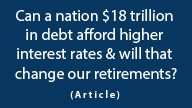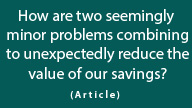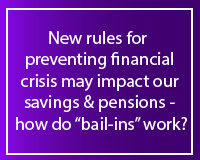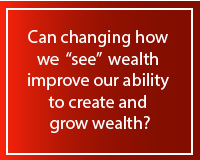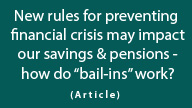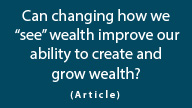The Gold/Housing Ratio As A Valuation Indicator
By Daniel R. Amerman, CFA
Below is the 2nd half of this article, and it begins where the 1st half which is carried on other websites left off. If you would prefer to read (or link) the article in single page form, the private one page version for subscribers can be found here:
Three For Three Correlation
There is another fascinating feature about the Gold/Housing ratio outliers, when measured on the basis of annual averages.
1) The peak price for gold in inflation-adjusted terms in the modern era occurred in 1980 at $1,707 an ounce (2012 dollars), That same year, the Gold/Housing ratio bottomed out at 100 ounces to buy a house.
2) The lowest price for gold in inflation-adjusted terms in the modern era occurred in 2001, when gold fell to $351 an ounce (2012 dollars). That same year, the Gold/Housing ratio peaked out at 565 ounces to buy a house.
3) The second peak and the second highest price for gold in inflation-adjusted terms in the modern era occurred in 2012 at $1,669 an ounce (annual average, 2012 dollars). That same year, the Gold/Housing ratio again bottomed out at 110 ounces to buy a house.
In all three instances, there was a 100% correlation when we look at the peak and bottom values for gold in inflation-adjusted dollar terms, and the peak and bottom values when we view gold in real estate terms.
Another way to view this is that while looking at gold in inflation-adjusted terms is very useful for identifying extreme valuations that may mark a turning point in the market, it is limited by the accuracy of the inflation measures. So if the official measures for three years were 2%, 1.5% and 2.5% – but that did not correspond to our personal experience – then what was the real rate of inflation for each of these years?
If we can't come up with an actual inflation number for each year that we believe to be accurate, then determining whether gold is undervalued or overvalued becomes problematic over a multiyear or multi-decade period, because we can't trust our data.
The advantage to the Gold/Housing ratio is that because the value of one tangible asset is being measured in terms of another tangible asset, the dollars drop out of the equation – and so do any concerns about the accuracy of the inflation measure.
It is also worth noting that the Gold/Housing ratio works differently in the other direction. That is, it did not call the peak in the real estate bubble – far from it. Instead, this ratio of relative values said that real estate was starting to get historically expensive compared to alternative investments right at the very time that the bubble was just starting to make an appearance. So the information value of the ratio was not to provide market timing for speculative trading within a bubble – but rather was a signal to long-term investors that a bubble was beginning.
Perceptions, Psychology & Long-Term Averages
Since that third turning point at the beginning of 2012, these have been difficult years to be a gold investor – and rewarding years to be a real estate investor.
Gold has been pummeled so badly, particularly as part of the commodities rout of the summer of 2015, that it seems irrationally low in price to many. On the other hand, real estate has been climbing for years now, and there are fears from some that it may even be entering another bubble phase.
Now, investors generally seek to buy low and to sell high. For most that means buying popular investments, and trying to follow the trend line in the hopes that already rising prices will rise still higher. The goal is to be a particularly astute member of the "herd" in other words, and to benefit from the movements of the many.
For contrarian investors on the other hand, seeking to buy low and sell high can mean the opposite. They may seek to invest in unpopular markets that have been driven to irrational lows. They may opt to get out of or even short markets that have been driven to irrational highs. In other words they seek to move the opposite direction of the "herd", in order to directly benefit from the return of rational pricing.
While each can enjoy their successes, there are also issues with both schools of investment thought. For example, markets usually look their very best – right before they crash. So a mainstream price trend follower who chases popular investments right along with everyone else – risks getting caught in a series of price bubbles, and suffering losses with each correction or bubble popping.
On the other hand, there is a well known saying that "markets can remain irrational for longer than any one investor can remain solvent", and financial history is full of examples that support that statement. So for a contrarian – if prices in a given market are irrational for perhaps multiple years, but they do eventually collapse – being eventually proven right does not protect one from potentially significant financial setbacks in the interim.
Now usually the distinction between a trend-follower and a contrarian is reasonably clear cut. In simplified form, a trend-follower would definitively buy real estate over gold, as real estate is popular and prices are rising, while gold is unpopular and prices are falling. Whereas a contrarian might do the opposite, believing there to be a strong case at this point to move out of overpriced real estate and into underpriced gold, and the sooner the better.
But how can the contrarian be sure about underpriced or overpriced? This is exactly where more long-term measures can be the most useful. As a truth-test on feelings, emotions, pervasive market psychology – and more generally, what we want to be true versus what is true.
The truth test is that the long-term average for the Gold/Housing ratio is 286 ounces to buy a house, and the current ratio is 203 ounces to buy a house. This would indicate that gold is overvalued by 41% relative to average single family residence prices in the United States, even with a $1,089 per ounce price for gold.
Yes, gold has been plunging. Yes, real estate has been steadily climbing. But the issue is that the starting point for both of these assets was a gross distortion of the normal value relationship, when the Gold/Housing ratio dropped below 100 ounces to buy an average house in late 2011. And yes, the ratio has doubled since then – but it needs to almost triple before historical averages are achieved.
Indeed, real estate is in the unusual place right now where both short-term trend followers and contrarians holding a long-term investment perspective might identify it as being a buy. For those who are drawn to rising prices – we are three years into a trend line of rising prices. For those seeking value pricing, and to buy in at prices below the long-term averages – real estate is still quite attractively priced relative to gold.
And what allows these two usually-opposing strategies to co-exist together is that the starting point was such a gross distortion compared to long-term averages. Because the gap was so great, that means that even after prices have traveled a considerable distance, there is still a lot more ground to travel before an average pricing relationship is reached.
Now, the qualifications and caveats are of course myriad, as they often are.
Real estate is the supremely local investment, and valuations in some local markets may indeed be reaching the irrational stage again, when we look at affordability measures. Which is precisely why this analysis uses the Freddie Mac index rather than the more publicized Case-Schiller measure – so that all fifty states are included, rather than only the 20 largest urban areas.
When we include Indiana and Wisconsin along with New York City and Boston, as well as Alabama and Kentucky along with Dallas and DC, and Nebraska and Idaho along with San Jose and Los Angeles – then based upon long-term averages, single family homes across the United States are still on average substantially undervalued relative to gold.
Now, financial system risk and rapid currency devaluation could certainly create extraordinary profits for precious metals.
Once we get away from the outliers, then any predictive power over the short and medium term can be poor, as the ratio can indeed just wander around in the middle for years on end. And the 40-year average of 286 ounces per home is far from being a stable destination, but rather it is just a number that can be passed quite quickly on the path from undervalued to overvalued, and vice versa.
But once we understand the limitations, and don't try to use this ratio for more than it can deliver – that is when we can use it to our advantage.
Whether one wants to think of housing being undervalued relative to gold, or gold being overvalued relative to housing, either way – that is clearly the current situation, and it is not even close on a national basis when compared to long-term averages.
This means that all else being equal, over a long enough period, an investment in housing will more likely than not outperform an investment in gold – possibly by a substantial margin – assuming that each investment tends to revert to the mean (i.e. return to average valuations) over time in the future, even as they have in the past.
And in a long-term strategy which employs both investments, then unless one is specifically investing for financial crisis, there is a case for putting an over-weight on housing, and an under-weight on gold, given current relative price levels.
Valid Perspectives Remain Valid, Years Later
The year 2011 was a stellar year for the gold bull market, and a low point for the real estate market. This was a time when many people felt absolutely confident as to which was the good investment versus the bad investment – indeed, the market consensus was overwhelming. Yet, out of the vast sea of commentaries about gold and real estate in 2011 – many are ludicrously out of date in 2015.
Now if a measure is to have genuine validity over the long-term, rather than just being a reflection of the market psychology of the moment, let me suggest that it needs to not be ludicrously out of date four years later.
The quoted text below is the word-for-word closing to my 2011 analysis (only the underlines have been added in 2015, for emphasis of on key sections).
"In my opinion, the best way to reconcile these two sides of contrarian investing - to bring together the need to buy low and sell high, while also meeting the need for liquid safety - is to say "both".
Gold and other precious metals have powerful advantages. There are some things they do that are better than any other investment alternative in the event of a currency or financial collapse. Having a significant holding of precious metals in a currency meltdown environment is simply irreplaceable.
Gold is not absolutely bound by 1980, and if the situation in 2012-2014 is far worse than the situation in the early 1980s, then we could see gold traveling an entirely different short term path, and it may still just be getting started compared to where it will go.
However, when we remove our gaze from the short-term, and we assume a return to history as we've seen over previous decades and centuries, then what the Gold / Housing ratio shows us is that gold is valued at an extremely high level, and real estate is remarkably cheap in comparison. To choose gold long-term while avoiding real estate long-term is to fight not only the averages but history itself - which by definition, has never worked.
So our solution is to not choose between the two assets but to purchase both kinds of contrarian assets with different objectives.
We choose precious metals to the extent that we are concerned about currency and financial system meltdown (although real estate has some powerful advantages as a precious metals complement in this situation as well).
If there isn't a currency meltdown - for someone attempting to build long-term value, then buying real estate at current prices is likely to be a far better source of long-term returns than gold, and likely to act as a much better inflation hedge.
The relative amount of assets devoted to each of these contrarian investments then depends on the individual investor's personal assessment of the likelihood of actual financial meltdown."
Judge for yourself – does that conclusion stand the test of time of the last four years? And if so, might an understanding of the implications of the Gold/Housing ratio provide meaningful insights (once appropriately adjusted for the current ratio and conditions) for the years and decades ahead?
 What you have just read is an "eye-opener" about one aspect of the often hidden redistributions of wealth that go on all around us, every day.
What you have just read is an "eye-opener" about one aspect of the often hidden redistributions of wealth that go on all around us, every day.
 A personal retirement "eye-opener" linked here shows how the government's actions to reduce interest payments on the national debt can reduce retirement investment wealth accumulation by 95% over thirty years, and how the government is reducing standards of living for those already retired by almost 50%.
A personal retirement "eye-opener" linked here shows how the government's actions to reduce interest payments on the national debt can reduce retirement investment wealth accumulation by 95% over thirty years, and how the government is reducing standards of living for those already retired by almost 50%.
 An "eye-opener" tutorial of a quite different kind is linked here, and it shows how governments use inflation and the tax code to take wealth from unknowing precious metals investors, so that the higher inflation goes, and the higher precious metals prices climb - the more of the investor's net worth ends up with the government.
An "eye-opener" tutorial of a quite different kind is linked here, and it shows how governments use inflation and the tax code to take wealth from unknowing precious metals investors, so that the higher inflation goes, and the higher precious metals prices climb - the more of the investor's net worth ends up with the government.
 Another "eye-opener" tutorial is linked here, and it shows how governments can use the 1-2 combination of their control over both interest rates and inflation to take wealth from unsuspecting private savers in order to pay down massive public debts.
Another "eye-opener" tutorial is linked here, and it shows how governments can use the 1-2 combination of their control over both interest rates and inflation to take wealth from unsuspecting private savers in order to pay down massive public debts.







If you find these "eye-openers" to be interesting and useful, there is an entire free book of them available here, including many that are only in the book. The advantage to the book is that the tutorials can build on each other, so that in combination we can find ways of defending ourselves, and even learn how to position ourselves to benefit from the hidden redistributions of wealth.


